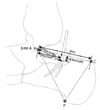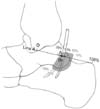1. National Health Insurance Service. To difficult walk 'Plantar fasciitis', female patients increased three times over the past five years [Internet]. Seoul: National Health Insurance Service;2013. cited 2015 Feb 1. Available from:
http://www.nhis.or.kr/bbs7/boards/B0039/3003.
2. Aldridge T. Diagnosing heel pain in adults. Am Fam Physician. 2004; 70:332–338.
3. Antoniadis G, Scheglmann K. Posterior tarsal tunnel syndrome: diagnosis and treatment. Dtsch Arztebl Int. 2008; 105:776–781.
4. Mahadevon V. Pelvic girdle and lower limb. In : Standring S, editor. Gray's Anatomy: The Anatomical Basis of Clinical Practice. Madrid: Elsevier;2008. p. 1425–1427.
5. Erickson SJ, Quinn SF, Kneeland JB, Smith JW, Johnson JE, Carrera GF, Shereff MJ, Hyde JS, Jesmanowicz A. MR imaging of the tarsal tunnel and related spaces: normal and abnormal findings with anatomic correlation. AJR Am J Roentgenol. 1990; 155:323–328.
6. Franson J, Baravarian B. Tarsal tunnel syndrome: a compression neuropathy involving four distinct tunnels. Clin Podiatr Med Surg. 2006; 23:597–609.
7. Lau JT, Daniels TR. Tarsal tunnel syndrome: a review of the literature. Foot Ankle Int. 1999; 20:201–209.
8. Radin EL. Tarsal tunnel syndrome. Clin Orthop Relat Res. 1983; (181):167–170.
9. Havel PE, Ebraheim NA, Clark SE, Jackson WT, DiDio L. Tibial nerve branching in the tarsal tunnel. Foot Ankle. 1988; 9:117–119.
10. Heimkes B, Posel P, Stotz S, Wolf K. The proximal and distal tarsal tunnel syndromes. An anatomical study. Int Orthop. 1987; 11:193–196.
11. Lam SJ. Tarsal tunnel syndrome. J Bone Joint Surg Br. 1967; 49:87–92.
12. Lamm BM, Paley D, Testani M, Herzenberg JE. Tarsal tunnel decompression in leg lengthening and deformity correction of the foot and ankle. J Foot Ankle Surg. 2007; 46:201–206.
13. Bareither DJ, Genau JM, Massaro JC. Variation in the division of the tibial nerve: application to nerve blocks. J Foot Surg. 1990; 29:581–583.
14. Dellon AL, Mackinnon SE. Tibial nerve branching in the tarsal tunnel. Arch Neurol. 1984; 41:645–646.
15. Williams EH, Williams CG, Rosson GD, Dellon LA. Anatomic site for proximal tibial nerve compression: a cadaver study. Ann Plast Surg. 2009; 62:322–325.
16. Gamie Z, Donnelly L, Tsiridis E. The "safe zone" in medial percutaneous calcaneal pin placement. Clin Anat. 2009; 22:523–529.
17. Govsa F, Bilge O, Ozer MA. Variations in the origin of the medial and inferior calcaneal nerves. Arch Orthop Trauma Surg. 2006; 126:6–14.
18. Andreasen Struijk LN, Birn H, Teglbjaerg PS, Haase J, Struijk JJ. Size and separability of the calcaneal and the medial and lateral plantar nerves in the distal tibial nerve. Anat Sci Int. 2010; 85:13–22.
19. Davis TJ, Schon LC. Branches of the tibial nerve: anatomic variations. Foot Ankle Int. 1995; 16:21–29.
20. Rondhuis JJ, Huson A. The first branch of the lateral plantar nerve and heel pain. Acta Morphol Neerl Scand. 1986; 24:269–279.
21. Gould JS. Recurrent tarsal tunnel syndrome. Foot Ankle Clin. 2014; 19:451–467.
22. Kim K, Isu T, Morimoto D, Sasamori T, Sugawara A, Chiba Y, Isobe M, Kobayashi S, Morita A. Neurovascular bundle decompression without excessive dissection for tarsal tunnel syndrome. Neurol Med Chir (Tokyo). 2014; 54:901–906.















 PDF
PDF ePub
ePub Citation
Citation Print
Print



 XML Download
XML Download